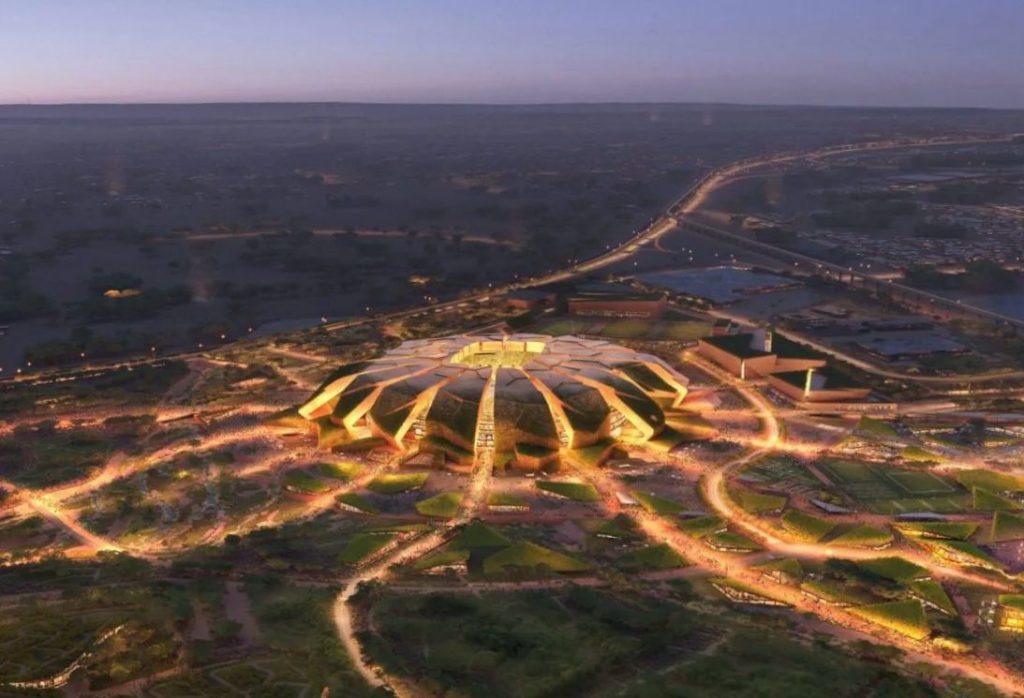King Salman Stadium Ready For Entry By 2029 or Nether The Less Preparing To Redefine The Future Of The Stadium All Together?
By Rose Polipi
Riyadh is preparing to change the world. Again. And it’s doing so not with a whisper—but with a roar that echoes through concrete, steel, and visionary design.
The King Salman Stadium, masterplanned by the architectural giants at Populous, is not just “on track” for a 2029 opening—it’s tracking a new trajectory for what stadiums can mean. Not just for sport. Not just for culture. But for the very identity of a nation surging toward the future at breakneck speed.Forget the term “multi-use.” That sounds almost too humble. This is a hyper-adaptive architectural colossus, a temple of next-generation events, poised to host everything from FIFA spectacles to global esports tournaments, world-class concerts, and technological showcases we haven’t even invented yet. It is no longer about fitting events into a stadium—it’s about designing a stadium that grows around the pulse of the world.

From Riyadh With Vision
Populous calls it an “iconic sports and entertainment venue.” But calling King Salman Stadium just that would be like calling the Eiffel Tower “a tall metal thing.” This isn’t just design. It’s declaration.
Spanning the plateau of Qiddiya, the stadium will be perched on a dramatic cliff edge overlooking the horizon—a place where architectural audacity meets the emotional drama of live sport. The view is symbolic: Saudi Arabia isn’t just looking outward, it’s looking forward.
From a design perspective, the stadium is unlike anything else currently planned or built. It will feature a fully retractable roof and pitch, enabling events in any weather and morphing the space with seamless transitions. But that’s just hardware. What makes this stadium an idea rather than just an edifice is the software of imagination behind it.
Tech, Culture, and Majesty Collide
Can one stadium contain a national vision? This one intends to.
With Qiddiya’s wider project already being dubbed the “capital of entertainment, sports and culture” in the Kingdom, King Salman Stadium is its crown jewel—a literal and figurative apex of national ambition.
This venue will anchor a dynamic future-ready sports ecosystem: sports medicine hubs, elite athlete training facilities, cultural fusion zones, interactive fan areas, immersive AR-enhanced visitor experiences… all integrated into a singular, user-responsive megastructure.
And lest we forget—this is named for King Salman bin Abdulaziz Al Saud, a monarch whose era has been defined by transformation, renewal, and cultural reinvention. The stadium is his architectural embodiment, and its success will be measured not only in attendance but in inspiration.
Will It Be Ready by 2029?
Now for the cynics’ favourite question: “Will it really be ready by 2029?”
Let’s not reduce this to a bureaucratic guessing game. Construction timelines can shift. So can the Earth’s tectonic plates. What matters more is that Saudi Arabia has proven, time and again, that when it sets its sights on the spectacular—it delivers.
From NEOM to the Red Sea Project, from AlUla’s cultural metamorphosis to Riyadh Season, the Kingdom doesn’t just build structures. It builds legacies.
So whether the doors open exactly on time or six months later is almost beside the point. The real question is: Will the world be ready for it when it opens?
A Stadium That Dares to Ask: What Is the Future?
What makes King Salman Stadium more than a construction project is that it isn’t merely trying to beat the best in the world. It’s trying to redefine what best even means. This is a place where architecture isn’t static, but kinetic—responsive, environmental, transformative.
In this context, the very question of “completion” takes on a new meaning. When a stadium becomes a living organism of culture, technology, and national pride, it doesn’t just open—it awakens. And in that light, King Salman Stadium might already be ready—not for 2029—but for the 22nd century
Final Thought:
If the Populous vision fully realizes its potential—and all signs suggest it will—this will not merely be one of the world’s greatest stadiums. It will be an architectural reset button, a place future designers will study, dissect, and aspire toward.
It’s not just concrete and glass. It’s the soul of Saudi ambition, made visible—and maybe, just maybe, audible from every seat on Earth.
So yes, King Salman Stadium is “ready”—but perhaps not just for entry.
It might well be ready for eternity.
